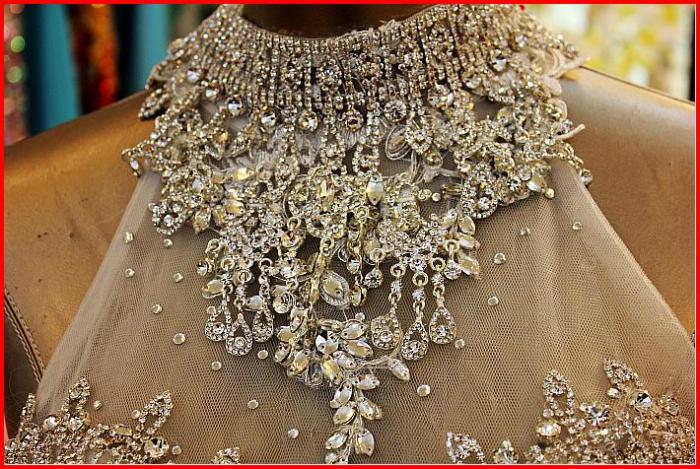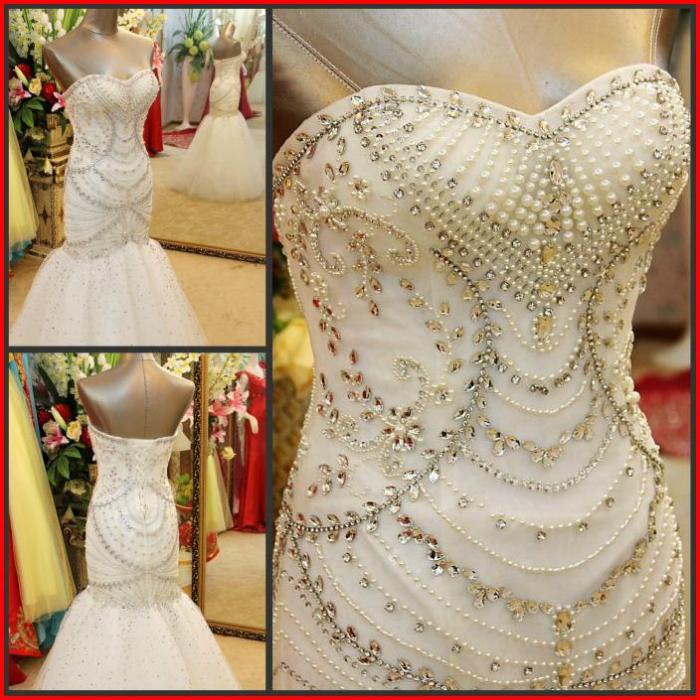Swarovski Crystal Application Techniques on Wedding Dresses
Swarovski crystals on wedding dress – Applying Swarovski crystals to a wedding dress requires precision and the right technique to ensure a stunning and long-lasting result. Several methods exist, each with its own advantages and disadvantages regarding durability, cost, and the level of skill required. The choice depends on the dress fabric, design complexity, and the bride’s budget.
Methods for Applying Swarovski Crystals
Three primary methods are commonly used: sewing, gluing, and heat-setting. Sewing offers the most secure and durable attachment, particularly for delicate fabrics. Gluing provides a quicker application but may be less durable, especially with heavier crystals or in areas subject to friction. Heat-setting, using specialized tools and adhesives, offers a strong bond but requires specific training and equipment.
- Sewing: This involves hand-sewing or using a sewing machine with a fine needle and strong thread. It’s ideal for delicate fabrics like lace and tulle, providing excellent durability. Tools needed include needles, thread, tweezers, and possibly a magnifying glass for smaller crystals. A drawback is the time-consuming nature, especially for intricate designs.
- Gluing: This method uses specialized crystal adhesives designed for fabric. It’s faster than sewing but requires careful application to avoid visible glue residue. Tools include a precision applicator, tweezers, and potentially a sealant to protect the glue from moisture. The potential drawback is that the glue may yellow over time or fail under stress, leading to crystal loss.
- Heat-Setting: This method employs a heat-setting tool and specialized adhesive that bonds the crystal to the fabric with heat. It offers a strong bond and is suitable for various fabrics. However, it requires specialized equipment and training, and incorrect application can damage the fabric.
Durability and Longevity of Crystal Application Techniques
The durability of crystal application varies significantly depending on the chosen method. Sewing generally offers the longest-lasting results, with crystals securely attached and less prone to loss. Gluing provides moderate durability, while heat-setting, when done correctly, can also be quite durable. However, factors like fabric type, crystal size, and wear and tear influence the longevity of all methods. Improper application or exposure to harsh chemicals can shorten the lifespan of crystals regardless of the method used.
Step-by-Step Guide: Hand-Sewing Crystals onto Delicate Lace

Source: cloudfront.net
- Prepare the dress: Lay the dress flat on a clean, padded surface.
- Plan the design: Sketch the desired crystal placement on the dress using a water-soluble pen.
- Select crystals and thread: Choose crystals appropriate for the lace and a strong, fine thread that matches the dress color.
- Sewing: Use a small needle and carefully sew each crystal using small, secure stitches. Ensure the stitches are hidden as much as possible.
- Inspect: After completion, inspect the dress for loose crystals or uneven stitching.
Design Considerations for Swarovski Crystals on Wedding Dresses
The successful integration of Swarovski crystals into a wedding dress design requires careful consideration of several factors. The style of the dress, the chosen crystal patterns, and the color palette all play a crucial role in the overall aesthetic.
Wedding Dress Styles and Crystal Embellishments
Certain wedding dress styles lend themselves particularly well to Swarovski crystal embellishments. For example, a simple A-line silhouette can be elegantly enhanced with a scattered crystal pattern, while a more elaborate ballgown can accommodate more intricate designs. Similarly, a sheath dress might benefit from strategically placed crystals along the neckline or waistline to add sparkle and definition. The key is to balance the crystals with the dress’s inherent elegance and avoid overwhelming the design.
Crystal Patterns and Designs
Numerous patterns and designs can be created using Swarovski crystals. Floral motifs, geometric patterns, scattered placements, and even custom designs are all possible. A scattered placement of smaller crystals can create a subtle shimmer, while larger crystals arranged in a specific pattern can produce a more dramatic effect. Intricate designs may require professional expertise.
- Floral Motifs: Crystals can be arranged to create delicate floral patterns, enhancing the romantic aspect of the dress.
- Geometric Patterns: Precisely placed crystals can form geometric designs, adding a modern touch to the dress.
- Scattered Placements: A random distribution of crystals can create a subtle sparkle across the fabric.
Impact of Crystal Color, Size, and Shape

Source: cloudfront.net
The color, size, and shape of the crystals significantly impact the overall aesthetic. Clear crystals provide a classic, elegant sparkle, while colored crystals can add a pop of color or complement the dress’s color scheme. Larger crystals create a more dramatic effect, while smaller crystals offer a subtle shimmer. The shape of the crystal (round, square, etc.) also influences the light reflection and overall design.
Cost and Sourcing of Swarovski Crystals for Wedding Dresses
The cost of Swarovski crystals depends on several factors, including size, cut, color, and quantity. Sourcing crystals from reputable suppliers ensures high quality and consistent results. Budgeting for crystal embellishments is essential for managing costs effectively.
Factors Influencing the Cost of Swarovski Crystals, Swarovski crystals on wedding dress
| Crystal Size (mm) | Crystal Cut | Crystal Color | Estimated Cost per Unit (USD) |
|---|---|---|---|
| 2 | Round | Clear | $0.10 – $0.20 |
| 4 | Round | Crystal AB | $0.30 – $0.50 |
| 6 | Square | Light Rose | $0.60 – $1.00 |
| 8 | Pear | Jet | $1.50 – $2.50 |
Note: Prices are estimates and can vary depending on the supplier and quantity purchased.
Reputable Sources for Swarovski Crystals
Several reputable online and offline retailers specialize in selling Swarovski crystals. Comparing prices and service quality from different suppliers is recommended to find the best value. Look for suppliers with a proven track record and positive customer reviews.
Budget Breakdown for Swarovski Crystal Embellishments
A detailed budget should include the cost of crystals, labor (if outsourcing application), and any additional materials like adhesives or thread. The total cost will depend on the dress’s size, design complexity, and the quantity of crystals used. A realistic estimate should be developed in consultation with a professional.
Care and Maintenance of Swarovski Crystals on Wedding Dresses
Proper care and maintenance are crucial for preserving the beauty and longevity of Swarovski crystals on a wedding dress. Careful cleaning and storage practices can prevent damage and maintain the dress’s appearance for years to come.
Cleaning and Preserving Swarovski Crystals
After the wedding, the dress should be professionally cleaned by a specialist experienced in handling delicate fabrics and crystal embellishments. Avoid harsh chemicals or abrasive materials that could damage the crystals or the fabric. Gentle hand washing with a mild detergent might be considered for less intricate designs, but professional cleaning is always the safest option.
Common Problems and Prevention
Common problems include crystal loss, discoloration, and glue residue. Regular inspection can help identify and address issues promptly. Proper storage can prevent many problems. Avoiding exposure to excessive heat, moisture, and direct sunlight is crucial.
Storing a Wedding Dress with Swarovski Crystals
Store the dress in a cool, dry place, ideally in a breathable garment bag to protect it from dust and light. Avoid hanging the dress for extended periods, as this can cause stretching and damage. Acid-free tissue paper can be used to cushion the crystals and prevent them from rubbing against each other.
Swarovski Crystals and Wedding Dress Trends: Swarovski Crystals On Wedding Dress
Swarovski crystals continue to be a popular embellishment for wedding dresses, with trends evolving to reflect changing design styles and preferences. Cultural influences also play a role in the use of crystals in wedding attire.
Current Trends in Swarovski Crystal Use
Current trends show a preference for more subtle and strategically placed crystals, often integrated into the overall design rather than being the focal point. Minimalist designs with carefully chosen crystal accents are gaining popularity. The use of colored crystals to complement the dress color or add a pop of color is also a growing trend.
Cultural Variations in Crystal Use
The use of crystals on wedding dresses varies across different cultures. In some cultures, elaborate embellishments are traditional, while in others, a more understated approach is preferred. Understanding these cultural nuances is important for designing wedding dresses that reflect the bride’s heritage and personal style.
Crystal Placement on Wedding Dress Details
Swarovski crystals can be incorporated into various wedding dress details to enhance specific features. Necklines can be adorned with crystals to add sparkle and elegance. Sleeves can be embellished with delicate crystal patterns. A crystal belt can add a touch of glamour, while the train can be subtly enhanced with scattered crystals for a dramatic effect. Each placement creates a unique visual impact, adding a touch of sparkle and sophistication to the dress.
FAQ
Are Swarovski crystals heavy on a wedding dress?
The weight depends on the quantity and size of crystals used. Smaller crystals used sparingly will add minimal weight, while larger quantities of larger crystals could add noticeable weight.
Can I remove Swarovski crystals from my dress after the wedding?
This depends on the application method. Crystals sewn on can be carefully removed, but glued crystals may damage the fabric upon removal. Consult a professional for safe removal.
How do I prevent crystals from falling off my wedding dress?
Secure application is key. Sewing is generally more durable than gluing. Use high-quality adhesive if gluing, and ensure the crystals are properly adhered to the fabric.
What happens if a crystal falls off during the wedding?
Have a few extra crystals and a small tube of adhesive on hand for quick repairs. Alternatively, consider having a seamstress or tailor on standby.
Are there any ethical considerations when buying Swarovski crystals?
Swarovski has sustainability initiatives, but sourcing from reputable vendors ensures ethical production practices. Look for certifications and transparent sourcing information.